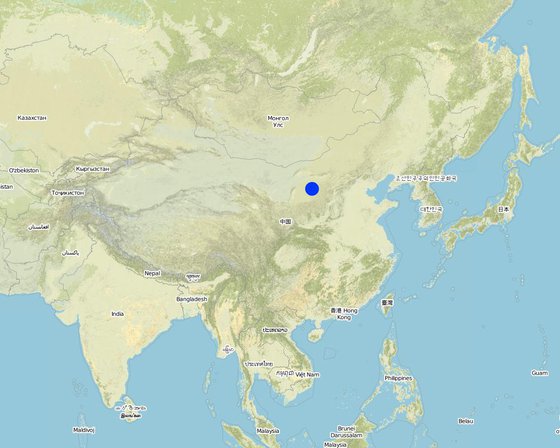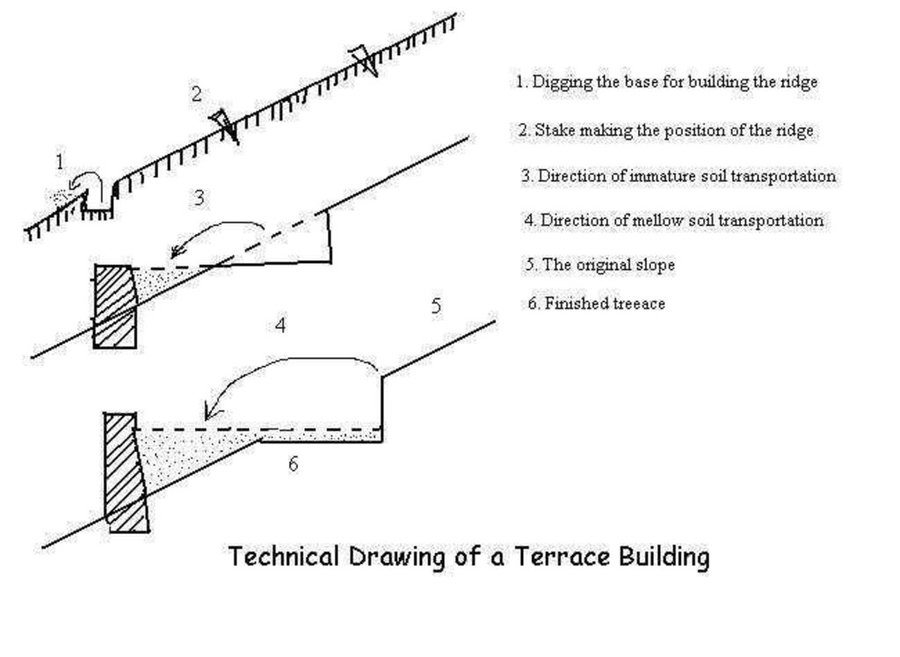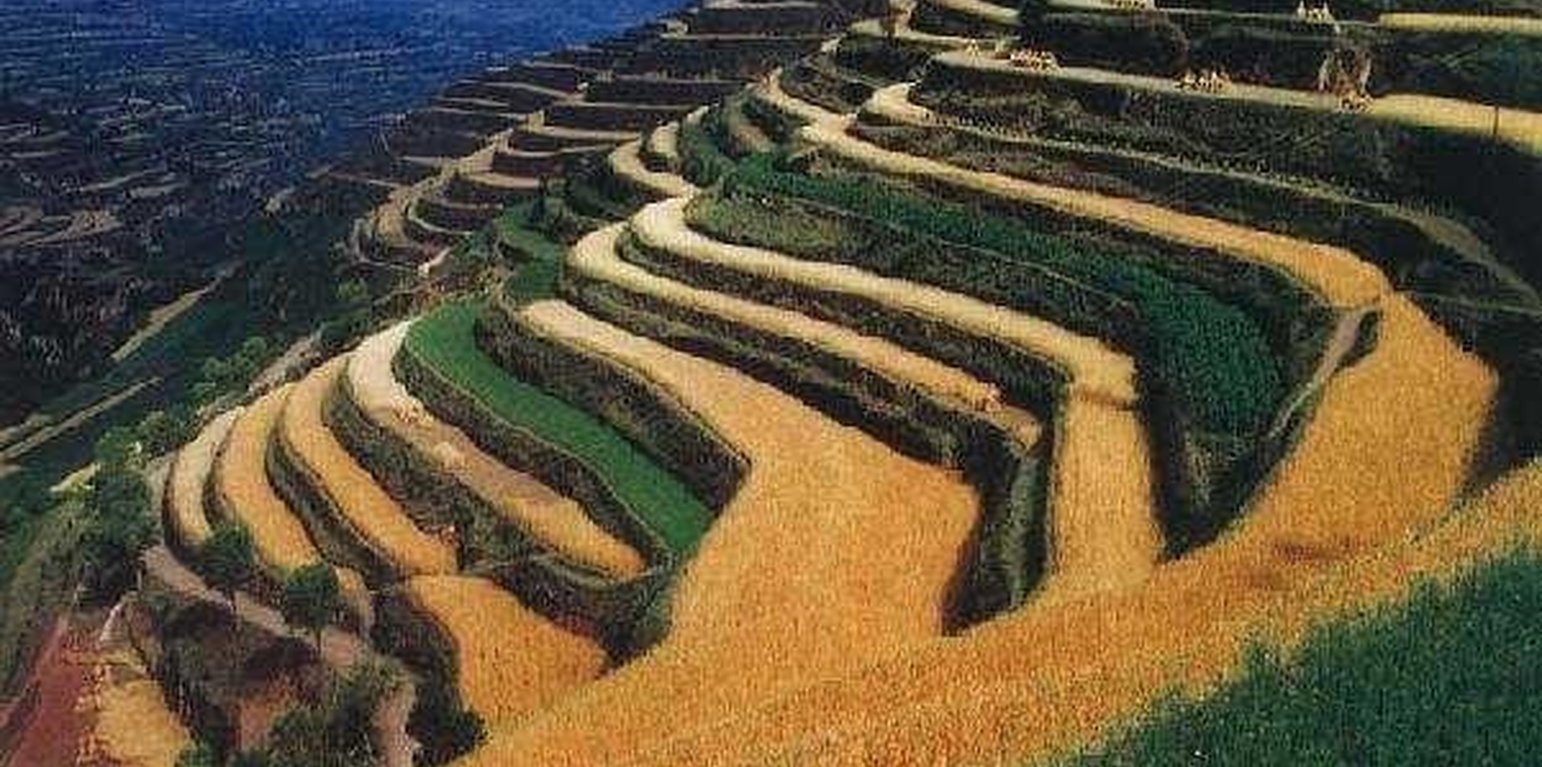Description
A terrace is a kind of measure to change the slope, which has a raised bank of earth or stone with vertical or sloping sides and a approximately flat top.
A terrace has a raised bank of earth or stone with vertical or sloping sides and a approximately flat top. It can reduce slope angle and length, retain runoff, increase infiltration and reduce the soil loss. Crops can grow well because water increases in soils. Meanwhile, ground cover is improved. Terrace can be constructed by manual labor or machine. Firstly, determining the width of the field according to the slope angle and soil texture. Secondly, putting the topsoil aside. Thirdly, leveling up the slope and constructing banks. At last, putting the topsoil to the top of the flat surface.
Location

Location: Shaanxi, Shanxi, Inner Mongolia, Henan, Gansu, China
No. of Technology sites analysed:
Geo-reference of selected sites
Spread of the Technology: evenly spread over an area (26666.7 km²)
In a permanently protected area?:
Date of implementation: more than 50 years ago (traditional)
Type of introduction
-
through land users' innovation
-
as part of a traditional system (> 50 years)
-
during experiments/ research
-
through projects/ external interventions
Technical drawing
Technical specifications
Drawings of a terrace building in the Loess Plateau
Location: the Loess Plateau. Shaanxi, Shanxi, Henan, Gansu, Inner Mongolia
Date: 2002
Technical knowledge required for field staff / advisors: high
Technical knowledge required for land users: low
Main technical functions: reduction of slope angle, reduction of slope length
Construction material (earth): Construct ridge of terrace
Construction material (stone): Construct ridge of terrace
Slope (which determines the spacing indicated above): 25%
If the original slope has changed as a result of the Technology, the slope today is: 10%
Lateral gradient along the structure: 80%
For water harvesting: the ratio between the area where the harvested water is applied and the total area from which water is collected is: 1:6

Author: BAI Zhanguo, Beijing China
References
Reviewer
-
David Streiff
-
Alexandra Gavilano
Date of documentation: Dec. 29, 2010
Last update: March 19, 2019
Resource persons
-
Meili WEN - SLM specialist
Full description in the WOCAT database
Documentation was faciliated by
Institution
- Department of Resources and Environmental Science, Beijing Normal University (Department of Resources and Environmental Science, Beijing Normal University) - China
Project
Key references
-
(inner resources) Suide Water and Soil Conservation examination station of Yellow River Water Resources Committee.. 1981.: orpus of Test Research of Water and Soil Conservation (the second volume), p130~185.
-
(inner resources) Water and Soil Conservation Department of Yellow River Water Resources Committee of Ministry of Water Resources and Electric Power.. 1987.: Corpus of economic benefits of water and soil measures, p77~102 ,510~514
-
Dongyinglin,Changpiguang ,Wangzhihua. Discussion on the several questions on increasing production of the terrace with two banks.. 1990.: Soil and Water Conservation Science and Technology in Shanxi, No.1, p36~37
-
Jiangdingsheng. Discussion on section design of the terrace on the Loess Plateau.. 1987.: ACTA CONSERVATIONIS SOLI ET AQUAE SINICA, Vol.1, No.2,p28~35.
-
Liangqichun, Changfushuang , Liming. A study on drawing up budgetary estimate quota of terraced field.. 2001.: Bulletin of Soil and Water Conservation, Vol.21,No.5, p41~44.
-
Liumingquan, Zhangaiqin, Liyouhua. Pattern engineering of reconstruction the slope cropland.. 1992.: Soil and Water Conservation Science and Technology in Shanxi, No.3, p18~21.
-
Lixuelian,Qiaojiping. Synthetic technology of fertilizing and improving production on the new terrace.. 1998.: Soil and Water Conservation Science and Technology in Shanxi, No.3, p13~14.
-
Ministry of Water Resources of China. Terraces in China.. 1989.: The press of Jilin science & technology.
-
Wangxilong,Caiqiangguo,Wangzhongke. The consolidating function and economic benefit analysis of the terrace hedgerows in the hilly loess region of northwest Hebei Province.. 2000.: Journal of Natural Resources,Vol.15, No.1, p74~79.
-
Xuyuanxu.The surveying report of the terrace benefits in yanbian autonomous prefecture. 1995.: Water and Soil Conservation,No.4, p50~52.
-
Zhujianqiang,Lijing. Experimental study on soil compact characteristics and its shearing strength in changing slope field into terrace on south shaanxi province.. 2000.: ransaction of the CSAE,Vol.16, No.2, p36~40.








